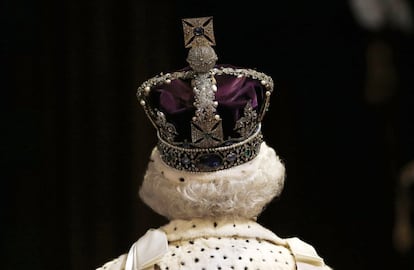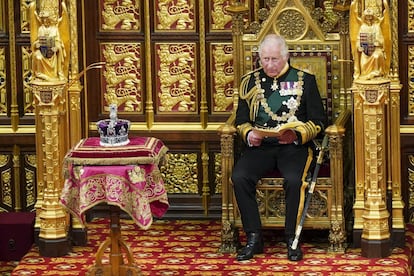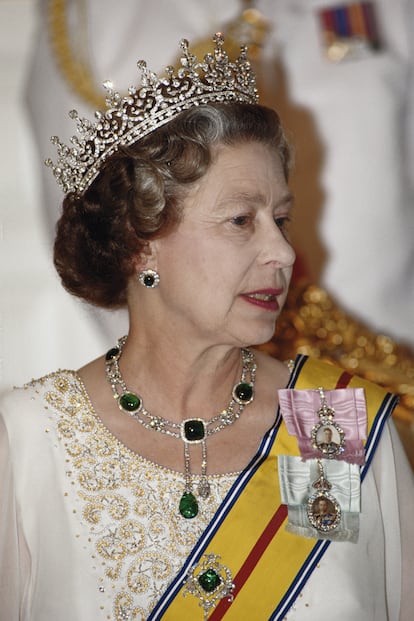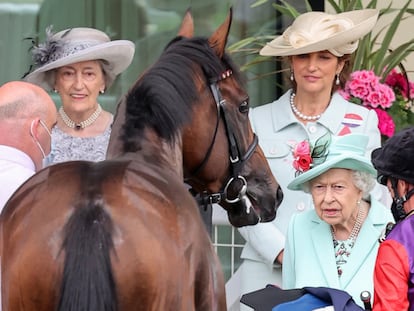From curses to conflicts: What will happen to Queen Elizabeth’s Crown Jewels?
The late monarch’s personal collection of jewelry is valued at over €120 million, and there is much speculation about who will receive which items

Legend has it that all the men who have owned the Koh-i-Noor have fallen from grace. A Hindu text from the 14th century states that “he who owns this diamond will own the world, but will also know all its misfortunes. Only God or woman can wear it with impunity.” No one has dared to challenge the prophecy, but things could change, as it is a man, King Charles III, who has just inherited the diamond.
The Koh-i-Noor, also spelled Kohinoor, is one of the largest diamonds in the world. Wars have been fought in its name. It belonged to Hindu, Mongol, Persian and Afghan monarchs. And in 1877, it passed into the hands of the British royal family, when Queen Victoria was named Empress of India. The jewel was set in the center of the Crown of Queen Elizabeth (later known as the Queen Mother) in 1937 for her coronation as queen consort. And now King Charles III has inherited the crown. Many hope that he will not be the one to wear it and that, following family tradition – or superstition – he will give it to his wife, the queen consort Camila Parker-Bowles. But India is after a different outcome.
The death of Queen Elizabeth II, on September 8, has reignited a longstanding dispute. Indian authorities believe that the diamond was taking illegally from the country, and was not a gift as the British royal family maintains. They are calling for the Koh-i-Noor to be returned, arguing that its inclusion in the royal crown is a hangover from the days of Britain’s colonization of India. These calls have been building on social media, where #Kohinoor became a trending topic as soon as the monarch’s death was announced. The dispute was raised back in 2010, when the then-British prime minister, David Cameron, said on Indian television. “What tends to happen with these questions is that if you say yes to one, then you would suddenly find the British Museum empty,” he told the local NDTV news channel, in a statement that quickly went viral.
But it is not just the Koh-i-Noor that has a sinister backstory. The Crown Jewels – a collection of jewels and treasures that is considered to be the most valuable in the world – are filled with stories of curses, palace intrigues and international conflicts.

More than two million people visit the Crown Jewels at the Tower of London every year. The collection belongs to the British monarchy, not to Queen Elizabeth herself, meaning they have automatically been passed on to King Charles III. The new sovereign, however, can loan them to different members of the royal family, as his mother did in the past. Kate Middleton, Prince William’s wife, has worn tiaras, brooches and chokers belonging to the royal family, as has Queen Consort Camila. And even Meghan Markle, before she and her husband Prince Henry distanced themselves from the family, wore them to special events, including her wedding. Typically, these pieces are only used for the coronation of a monarch, in official portraits, and on some ceremonial occasions.
What jewels will the queen be buried with?
A state funeral and a coronation are two very ceremonial events, so there is much speculation about what jewels will be featured. During the funeral, the queen’s coffin will be decorated with four objects, as tradition dictates: the Royal Standard, the Sovereign’s Scepter with Cross, the Sovereign’s Orb and the State Crown. The latter features more than 3,000 precious stones, but it is one in particular that has caught the attention of the press. The Cullinan Diamond, also known as the Great Star of Africa, was found in South Africa in 1905. A Boer general bought the stone and gave it to Edward VII, King of the United Kingdom at the time, as a token of the loyalty of the Boer people. The gift was made a few years after the Second Boer War, in which the British empire fought two Boer Republics: the South African Republic and the Orange Free State. Even back then, the gesture was seen as an act of colonialist servitude, and today many South Africans are calling for the diamond to be returned.
While it is known what will adorn the queen’s coffin, there is less information about the jewels she will be buried with. Lisa Levinson, head of communications for the Natural Diamond Council jewelers association, told the British outlet Metro that the queen “is unlikely to be laid to rest in anything but her simple Welsh gold wedding band and a pair of pearl earrings.” Levinson said that the queen’s engagement ring, which belonged to Philip of Edinburgh’s mother, Princess Alice of Battenberg, will probably be given to Princess Anne, although this has not been officially confirmed.

Less is known about King Charles’ coronation ceremony, which will take place in 2023 (what took place a few days ago was the proclamation). Several British media believe the ceremony will be smaller, shorter and cheaper than his mother’s coronation in 1953. Charles III will receive St Edward’s Crown, the centerpiece of the Crown Jewels, from the Archbishop of Canterbury. It is the most valuable crown in the collection, the one used to crown the monarchs of the United Kingdom. It was made for the coronation of King Charles II. Camila is expected to wear the Crown of Queen Elizabeth, with the Koh-i-Noor.
There are also questions about what will happen to Queen Elizabeth’s personal jewelry collection, which is not connected to the monarchy, and can be bequeathed freely. The 300-piece collection, which is worth more than €120 million, is largely made up of jewelry Queen Elizabeth inherited from her grandmother, Queen Mary of Teck, and her great-great-grandmother, Queen Victoria. Some British outlets suggest that the items will be divided between Camilla, Kate Middleton and her daughter Charlotte.
But Lauren Kiehna, author of the book The Court Jeweler, disagrees. In an interview with the online magazine Page Six, Kiehna suggests that the queen will bequeath everything to her son, for historical and financial reasons. “I think it’s very likely that the Queen has followed in the footsteps of her grandmother, Queen Mary, and her mother, Queen Elizabeth the Queen Mother, and bequeathed all of her jewelry directly to the new monarch, King Charles III,” she said. What’s more, direct inheritance between monarchs, as is the case with Queen Elizabeth and King Charles, is free of the 40% tax that applies to any other inheritance in England that exceeds £325,000 ($374,000).
But the public will never know. Since 1911, the British royal family has managed to get around UK law, which requires that the wills of British citizens be made public. The practice of sealing royal wills began with the death of Prince Francis of Teck in 1910. In his will, this well-known womanizer bequeathed his family’s most valuable jewels to his mistress, a noble and married woman. Queen Mary of Teck, Francis’ sister, asked the court to make her relative’s will secret to avoid a scandal. And she succeeded, setting a precedent that the Windsors have clung to every time a family member has died. During this time, the family has asked the court to keep 33 wills secret, while assets worth at least £187 million (about $217 million) by today’s standards have been distributed behind the public’s back, according to calculations by The Guardian. The court has never rejected one of these requests.
As for the jewels bequeathed to the noblewoman, Mary of Teck bought them back for around £10,000 ($11,500) and kept them in the family. Queen Elizabeth II wore them on more than one occasion. Now she will bequeath them, secretly and perhaps tax-free, among her own family.
Tu suscripción se está usando en otro dispositivo
¿Quieres añadir otro usuario a tu suscripción?
Si continúas leyendo en este dispositivo, no se podrá leer en el otro.
FlechaTu suscripción se está usando en otro dispositivo y solo puedes acceder a EL PAÍS desde un dispositivo a la vez.
Si quieres compartir tu cuenta, cambia tu suscripción a la modalidad Premium, así podrás añadir otro usuario. Cada uno accederá con su propia cuenta de email, lo que os permitirá personalizar vuestra experiencia en EL PAÍS.
¿Tienes una suscripción de empresa? Accede aquí para contratar más cuentas.
En el caso de no saber quién está usando tu cuenta, te recomendamos cambiar tu contraseña aquí.
Si decides continuar compartiendo tu cuenta, este mensaje se mostrará en tu dispositivo y en el de la otra persona que está usando tu cuenta de forma indefinida, afectando a tu experiencia de lectura. Puedes consultar aquí los términos y condiciones de la suscripción digital.
More information
Últimas noticias
Most viewed
- Sinaloa Cartel war is taking its toll on Los Chapitos
- Oona Chaplin: ‘I told James Cameron that I was living in a treehouse and starting a permaculture project with a friend’
- Reinhard Genzel, Nobel laureate in physics: ‘One-minute videos will never give you the truth’
- Why the price of coffee has skyrocketed: from Brazilian plantations to specialty coffee houses
- Silver prices are going crazy: This is what’s fueling the rally











































